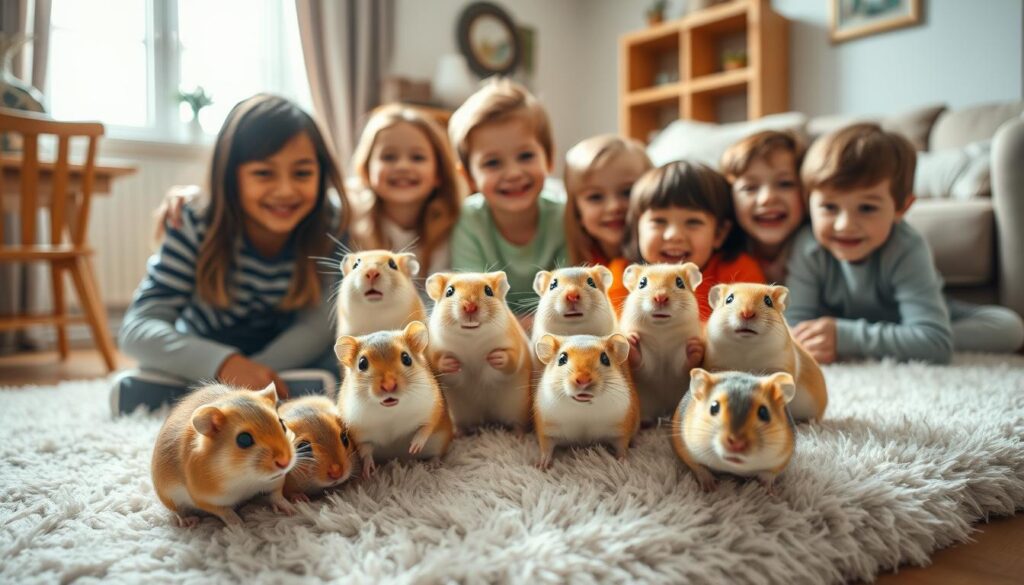Did you know gerbils were first brought to the U.S. in the 1950s for research, not as pets? Today, they win the hearts of millions. But, do they really make good pets? As someone who’s cared for gerbils, I’ve learned about their wild side. It shapes how they act around people.
Are gerbils as friendly as they seem? This guide will uncover their social quirks, care needs, and why they’re more than just cute pets.
Table of Contents
Key Takeaways
- Gerbils are highly social rodents with distinct personalities.
- Proper handling from youth boosts their friendliness as small pets.
- They thrive best when kept in pairs or groups rather than alone.
- Understanding their body language is key to building trust.
- Over 2 million U.S. households now choose gerbils as pocket pets.
Introduction to Gerbils as Pocket Pets
Gerbils are popular pets because they are small and lively. They come from dry areas in Mongolia and China. To keep them healthy and happy, you need to understand their needs.
Origins and Natural Habitat
Wild gerbils live in deserts and dig burrows to stay cool. They like to forage and live in groups. This means they need lots of space to dig in their cages.
Gerbil Characteristics and Lifespan
Gerbils are 4–6 inches long and weigh 2–4 ounces. They have long tails and strong back legs. They live for 2–4 years, which is a good amount of time for a pet.
They are fun to watch and love to explore. This makes them great pets for many people.
Common Gerbil Breeds in the US
There are three main types of gerbils in the US:
| Breed | Key Traits | Care Notes |
|---|---|---|
| Mongolian Gerbil | Most common; curious and active | Requires regular handling for socialization |
| Fat-Tailed Gerbil | Stores fat in tail; hardier than other breeds | Less frequent handling needs |
| Duprasi Gerbil | Smaller; shy demeanor | Needs quiet environments to thrive |
Learning about different gerbil breeds helps you choose the right one. Each breed has its own personality and needs. This is important for deciding if gerbils are a good fit for your home.
Are Gerbils Friendly? Understanding Their Temperament
Gerbils are curious and social, but their gerbil personality can vary. Some enjoy being around people, while others may not. Building trust takes time, but it’s worth it for the companionship they offer.
“Gerbils friendliness improves with patience and routine handling,” notes animal behavior studies.
Natural Behavioral Traits
Wild instincts guide their daily actions. Key traits include:
- Exploratory nature: Gerbils sniff, dig, and explore new things.
- Group harmony: They bond with cage mates, showing affection through chirping or grooming.
- Playful energy: They enjoy playing with tunnels and toys, showing their lively side.
Comparing Gerbil Friendliness to Other Rodents
Gerbils are very social compared to other small pets. Here’s how they compare:
- Hamsters: They are often solitary and less eager for handling.
- Mice: They are skittish and prefer quiet places.
- Rats: They are more interactive but need regular interaction.
Factors Affecting a Gerbil’s Personality
Several factors influence their gerbil temperament:
- Genetics: Littermates can have different energy levels.
- Early socialization: Handling them as babies helps build trust.
- Gender: Males tend to be calmer, while females are more active.
Each gerbil has its own unique traits. With care and patience, their friendliness grows. They are more than just pets; they are companions.
The Social Nature of Gerbils
Gerbils are social animals that need gerbil companionship. In the wild, they live in groups and form close bonds. Keeping them in gerbil pairs helps them feel less stressed and stay healthy.
Without friends, gerbils might seem tired or keep doing the same thing over and over. This is because they miss the company of others.
- Communicate through scent marking and soft chirps
- Groom each other to strengthen social bonds
- Sleep and play together in groups
| Behavior | Single Gerbil | Paired Gerbils |
|---|---|---|
| Social Interaction | Limited | Constant |
| Stress Levels | Higher risk | Lower |
| Activity | Less exploration | More playful |
When introducing gerbil pairs, start by letting them sniff each other through cages. Look for calm behavior before putting them together. Gerbils that grow up together bond the best.
Don’t mix males and females unless you’re planning to breed. It’s better to keep same-sex pairs to avoid too many gerbils.
Research shows gerbils in groups have fewer health problems. Their natural are gerbils social nature makes having friends crucial. Give them tunnels or hiding spots to keep their social structure intact. Make sure they have enough space to interact or find a quiet spot.
My Experience: Bonding with Gerbils

Building a bond with gerbils takes time, but it’s worth it. When I first got my gerbil, I focused on bonding with gerbils through patience and consistency. Here’s what I learned.
First Interactions and Building Trust
Starting slow was key. I sat quietly near their cage daily, letting them see me without sudden moves. Offering sunflower seeds from an open palm helped them grow comfortable. Over weeks, they began exploring my hand—proof that trust isn’t built overnight.
Reading Gerbil Body Language
Understanding gerbil body language made all the difference. Here’s what I decoded:
| Behavior | Meaning |
|---|---|
| Foot thumping | Alarm—signaling danger to the group |
| Teeth chattering | Agitation or stress |
| Purring (rapid vibrations) | Contentment, similar to cats |
| Freezing | Fear—stop moving until they relax |
Creating Positive Associations
I linked handling to rewards. Using a dust bath as a treat, I’d let them explore my palm first. Consistent routines, like daily 10-minute hand-taming sessions, reinforced safety. Respecting their “no” was crucial too—never forcing interaction if they hid or chattered teeth.
After six weeks, my gerbil climbed onto my shoulder voluntarily. This shows that are gerbils friendly depends on how we nurture trust through observation and patience.
Housing Requirements for Happy Gerbils
Thinking about are gerbils good pets? Their living space is crucial. A well-thought-out gerbil housing setup is key to their happiness. Here’s how to make their home perfect.
Cage Size and Setup Recommendations
Choose a gerbil cage setup that matches their lively nature. A glass tank with a secure mesh lid is best. Aim for at least 10 gallons per gerbil—more is always better.
Use aspen or paper-based bedding at least 4 inches deep. This lets them burrow naturally. Brands like Kaytee and Prevue offer great options.
| Requirement | Detail |
|---|---|
| Cage Size | 10+ gallons per gerbil |
| Bedding Depth | 4+ inches for digging |
| Substrate | Aspen or paper-based |
Enrichment and Toys
- Provide a solid-surface wheel (8-inch minimum) to prevent foot injuries.
- Add cardboard tunnels and chew toys for mental stimulation.
- Include fleece or hay for nesting, which helps them feel secure.
“A bored gerbil is a stressed gerbil,” says Dr. Emily Carter, a small animal vet. “Toys and tunnels keep them active and friendly.”
Creating a Stress-Free Environment
Put the cage in a quiet spot, away from drafts and loud noises. Use natural light by placing it near a window but not in direct sunlight. Clean weekly but leave some old bedding to keep scent markers.
Good gerbil housing lowers stress and boosts their social behavior. A well-designed space lets their playful side shine. This makes them the engaging pets many owners adore.
Gerbils and Children: A Good Match?

When thinking about are gerbils good pets for kids, watching them closely is crucial. Gerbils are small and lively, making them child-friendly pets with adult supervision. Kids under 8 might find it hard to handle them gently. But, older kids can learn to care for them with guidance.
Assigning tasks based on age can help families succeed. Here’s how it works:
- Children 6 and under: Observe but don’t handle
- 7–12 years: Feed, clean bowls, and assist with toys
- 13+ years: Handle gerbils with supervision
| Age Group | Kid Responsibilities | Adult Responsibilities |
|---|---|---|
| 6 & under | Watch and learn | All handling and cleaning |
| 7–12 | Fill food/water, clean cage accessories | Supervise interactions |
| 13+ | Handle gerbils with care | Health checks, vet visits |
“Gerbils teach patience better than many pets. They’re quiet and predictable, making them ideal for fostering responsibility.” — Dr. Laura Chen, Small Animal Veterinarian
As gerbils as family pets, they teach about biology and empathy. Their 2–4 year lifespan fits well with family schedules. Kids need to learn gentle handling to avoid stressing them out. With clear roles and patience, gerbils can become beloved pets that spark curiosity about nature and care.
Health Considerations for Prospective Gerbil Owners
Understanding gerbil health is crucial. Gerbils are small but need careful attention. Regular vet visits are essential to catch problems early. Here’s what you should know:
Common Health Issues
- Respiratory Problems: Wheezing or hard breathing means they need help fast.
- Scent Gland Tumors: These are more common in males and need surgery.
- Dental Issues
Veterinary Care Requirements
| Type of Care | Cost Range |
|---|---|
| Annual check-up | $50–$100 |
| Emergency surgery | $300+ |
| Parasite treatment | $20–$50 |
Keeping their habitat clean and adjusting their diet can save money. Always ask about a gerbil’s health before you adopt.
Lifespan and Long-Term Commitment
“Gerbils live 2–4 years, but their care demands consistency,” says Dr. Mia Chen, a certified exotic pet vet. “Plan for emergencies and routine vet visits.”
Even though gerbils are small, they need constant care. Their short lives mean owners must be ready for loss. Research are gerbils good pets to make sure you’re ready for their needs.
Gerbils vs. Other Small Pets: Making the Right Choice
Choosing between small pets depends on your lifestyle and what you like. Let’s look at the main differences to see if gerbils are right for you.
Gerbils vs. Hamsters
Gerbils are social animals and enjoy being with others. They get along well with their cage mates. Hamsters, on the other hand, like to be alone.
Gerbils are active all day and night, while hamsters are mostly active at night. Gerbil waste also smells less than hamster droppings.
- Social needs: Gerbils need buddies; hamsters do not.
- Handling: Gerbils adapt to routines; hamsters may bite if startled.
Gerbils vs. Mice and Rats
| Feature | Gerbils | Rats |
|---|---|---|
| Lifespan | 3-5 years | 2-3 years |
| Size | 4-6 inches | Larger, up to 12 inches |
| Temperament | Curious and playful | Intelligent but needs more mental stimulation |
Mice are shy and don’t live long. Rats are smart but need a lot of space and training. They can form strong bonds with their owners.
When Another Pet Might Be Better
If you prefer a pet that likes to be alone, hamsters are a good choice. Mice are small and don’t take up much space. Rats need time to train but can form deep connections with their owners.
If you have allergies, consider reptiles or fish. They are good alternatives.
Potential Challenges of Gerbil Ownership
Before getting gerbils, it’s important to know their special needs. Many find their quirks charming once they get used to them. But, these pets need care and attention to do well. Gerbil care difficulties like being active at night or chewing can surprise new owners.
Here are key points to consider before deciding if gerbils are good pets for your home:
- Burrowing instincts create messy cages, demanding frequent bedding changes.
- Chewing can destroy plastic cages—metal enclosures are safer choices.
- Territorial disputes may arise if new gerbils introductions aren’t gradual.
- Bedding dust or dander can trigger allergies in some owners.
- Traveling requires planning to maintain their habitat stability.
- Short lifespans (2–4 years) mean emotional readiness for loss.
- Bedding activity peaks at night, causing noise for light sleepers.
- Quick movements make them hard to handle for those unaccustomed to small pets.
- Household pets like cats/dogs may see gerbils as prey.
| Common Issue | How to Manage |
|---|---|
| Burrowing | Use deep bedding and large cages. |
| Chewing | Opt for metal enclosures and chew-proof toys. |
| Allergies | Wear a mask when cleaning and choose hypoallergenic bedding. |
“Their needs demand consistency,” says a small-pet vet. “Gerbils aren’t low-maintenance, but with care, they adapt well.”
These gerbil challenges show the need for research. While gerbil care difficulties exist, many find the bond rewarding. Ask yourself: Can you manage their active nature and habitat needs? Only you can decide if gerbils are good pets for your lifestyle.
How to Choose a Friendly Gerbil
Choosing the right gerbil is more than luck. Look for breeders or local shelters for a social pet. Gerbil adoption from trusted places can tell you about their personality and health.
Where to Adopt or Purchase
When choosing, compare adoption sources for a friendly match. Here are key points for each:
| Source | Pros | Cons |
|---|---|---|
| Reputable Breeders | Health records, hand-raised kits | Higher upfront cost |
| Animal Shelters | Vaccinated, adoption fees often low | Unknown early socialization |
| Local Pet Stores | Convenient locations | Variable handling history |
Signs of a Healthy, Well-Socialized Gerbil
- Clear eyes with no discharge
- Clean, fluffly fur without patches
- Active but calm movements
- Approaches hands without biting
Questions to Ask Breeders or Shelter Staff
Ask these important questions during your visit:
- What’s the gerbil’s age and litter history?
- Have they been handled regularly?
- Are health records available?
- What’s their diet routine?
- Are there any known behavioral issues?
Gerbils raised in groups often have better social skills. Be patient with shy gerbils. They can warm up over time. Choose breeders who provide temperament reports to fit your lifestyle.
Conclusion: Are Gerbils the Right Pet for You?
Thinking about getting a gerbil as a pet? First, understand their natural behavior. Gerbils are friendly and love being with others of their kind. They enjoy playing and exploring, but they need a home that fits their lifestyle.
Do you have enough space for a big cage with lots of toys? Can you afford to buy food and toys regularly? Gerbils need daily attention and should be handled gently. If you’re allergic, it’s smart to do an allergy test.
Gerbils live for two to four years, which is a big commitment. They sleep at night, which might disturb you. They are also very delicate, so you must be careful when handling them.
If you’re ready to care for a gerbil, they can be great pets. They are friendly and fun to watch. But, if you don’t have enough space or time, another pet might be better. Always think about what’s best for the animal and your lifestyle.
FAQ
Are gerbils good pets?
Yes, gerbils make great pets for those who love small, lively animals. They are friendly and social, making them fun to have around. But, it’s important to make sure they have a good home and friends.
Are gerbils social animals?
Absolutely! Gerbils love to be with others and do best in pairs or small groups. In the wild, they live in families. Being alone can make them sad and stressed.
How long do gerbils typically live?
Gerbils live for 2 to 4 years. This might seem short, but it’s good to be ready for it. It’s also important to think about the feelings of having a pet.
Do gerbils require a lot of interaction?
Gerbils don’t need a lot, but they do like to be handled. Handling them often helps them trust and enjoy being around people.
What do gerbils need for a suitable habitat?
Gerbils need a big cage, at least 10 gallons for each one. They like bedding for digging, tunnels for fun, and safe toys for their teeth. They also need things to do and places to hide.
Can gerbils be litter trained?
Yes, gerbils can learn to use a certain spot for the bathroom. It takes time and patience. Using safe, natural materials helps a lot.
Are gerbils hypoallergenic?
Gerbils are less likely to cause allergies than furry pets. But, some people might still react to their bedding or dander.
Do gerbils get along with other small pets?
Gerbils usually don’t get along with hamsters or mice. They can get territorial and fight. It’s best to keep them with their own kind.
What should I feed my gerbil?
Gerbils need a mix of commercial food, seed mixes, fruits, and veggies. Avoid sugary or fatty foods to keep them healthy.
How can I tell if my gerbil is happy?
A happy gerbil is active, curious, and plays with its friends. It eats well and grooms itself, showing it’s healthy and happy.






